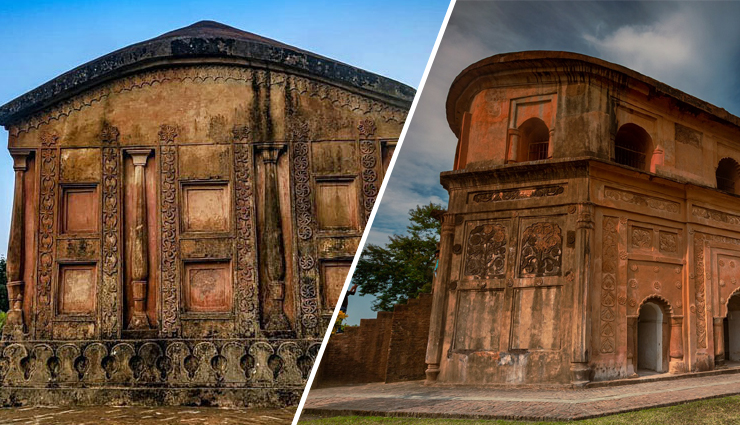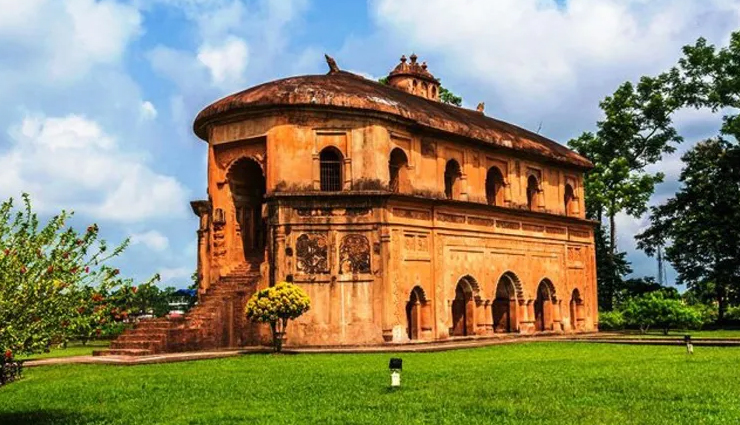
Embark on a journey to Northeast India and delve into Assam's storied past by exploring its renowned landmarks, including awe-inspiring forts, ancient temples, and grandiose palaces. Incorporate these historical gems into your travel itinerary and relish an enthralling heritage expedition through the heart of Assam.
Peruse this selection of renowned historical destinations in Assam to uncover its rich history and marvel at its exceptional architectural wonders.

Often referred to as the 'Colosseum of the East,' Rang Ghar stands as one of Asia's oldest surviving amphitheaters, earning its place among the premier historical sites in Sivasagar, Assam. The name Rang Ghar translates to the 'House of Entertainment,' and this two-story structure originally served as a royal sports pavilion, particularly during the vibrant Rongali Bihu Festival.
Dating back to the year 1746 AD, during the reign of the Ahom dynasty in Assam, this historical site holds significant historical importance and serves as a testament to the architectural finesse and grandeur of a bygone era.
In 2007, Rang Ghar was prominently featured as the emblem for the 33rd National Games hosted in Assam. Regrettably, frequent earthquakes in the region have inflicted damage upon the building, leaving 35 noticeable cracks on its walls. Nevertheless, its enduring magnificence continues to make it a worthwhile destination for visitors.
Hajo Powa Mecca boasts numerous legends intertwined with its history. According to one of these legends, it is believed that the foundation of this Mecca was established using soil brought directly from the sacred Mecca itself. Consequently, it stands as one of the most profoundly religious historical sites in Assam.
The term Hajo Powa Mecca translates to one-quarter of Mecca, and it is this association that leads people to believe that a visit here can bestow upon them one-fourth of the divine grace they might receive in Mecca. Isn't that a fascinating concept?
Constructed in 1657 under the reign of Shah Jahan by Mir Lutufullah-i-Shiraji, this mosque in Assam also houses the tomb of a renowned Islamic pioneer, Pir Giasuddin Auliya. The atmosphere here exudes serenity, attracting not only devout pilgrims but also history enthusiasts and regular tourists. If you're seeking a harmonious blend of sanctity and historical significance, Hajo Powa Mecca stands as the premier historical destination to explore in Assam.
Include Talatal Ghar in your roster of the top 10 historical landmarks in Assam. Referred to as Kareng Ghar as well, this monument stands as a remarkable testament to Assamese culture. Its distinction as the largest edifice among all Ahom monuments globally renders it a must-see attraction. If you possess an appreciation for history or architectural marvels, a visit to Talatal Ghar in Rangpur is highly recommended.
Talatal Ghar, which was commissioned between 1751 AD and 1769 AD, was the brainchild of the illustrious Ahom Swargadeo Rajeswar Singha. It once served as the royal residence of Assam's monarchs. The building's two tunnels and three subterranean levels were strategically designed to function as emergency retreats for the King and the army during times of peril. What sets this awe-inspiring monument apart is its construction from entirely organic materials, including bricks and a mixture of rice powder and duck eggs, adding to its distinction as a noteworthy architectural wonder.
Due to numerous archaeological findings, Surya Pahar in Assam has earned the moniker Archaeologist's Gold Mine. Situated 12 kilometers from the Goalpara district, Surya Pahar stands as one of the lesser-explored historical sites in Assam that should be on your must-visit list.
As its name suggests, Surya Pahar, which translates to the Hill of the Sun, is believed to have historical ties to the cult of sun worship. What are your thoughts on this intriguing connection? Furthermore, artifacts unearthed at this location are showcased in a local museum.
Local lore suggests that this historical site in Assam is adorned with an astounding 99,999 Shiva Lingas. Quite a remarkable claim, wouldn't you agree? Additionally, it's believed to be one of Assam's hidden historical gems, harboring numerous tales, mysteries, and potentially buried treasures.
Surya Pahar carries profound historical and religious significance for Hindus, Buddhists, and Jains alike. It has earned a place among the most significant heritage sites preserving ancient remnants in Assam.
Khaspur, once the capital of the Kachari kings during medieval times, stands as a renowned historical destination in Assam, drawing the admiration of numerous history enthusiasts. This site serves as a vivid testament to Assam's rich cultural heritage, and the remnants of Khaspur bear witness to the former grandeur of this place. Notably, Khaspur is celebrated for its Kachari Fort, which functioned as the royal seat of the Kachari Dynasty.
Within Khaspur, you can find a suryadwar (the gateway of the sun) and a devalaya (a place of worship for the gods). In the 18th century, this historical site in Assam came under the rule of the Dimasa Kachari after the Koch king passed away without a successor. It was during their reign that the Kachari Fort was constructed in Assam.
For a glimpse into the splendid history of Assam, Khaspur ranks among the finest historical sites to explore in the region.
Charaideo, believed to be the capital of the Ahom dynasty, was established by Sukapha, the dynasty's founder. Situated approximately 28 kilometers from Sibsagar town, this site serves as the final resting place for numerous Ahom monarchs and queens.
At the summit of the hill, you'll discover 42 tombs of these kings and queens, constructed from a combination of stone and bricks. These tombs offer a glimpse into the lifestyle and dwellings of the Ahom rulers during their era.
What's even more intriguing is that Charaideo has earned the nickname the Pyramids of Assam due to its architectural resemblance to the famous Egyptian pyramids. The architectural brilliance of the medieval period is on full display here, making Charaideo a must-visit among the top historical landmarks in Assam if you have an interest in such historical marvels.
Sukapha Samannay Kshetra stands as a tribute to Sukapha, the inaugural Ahom king of Assam, also known as Siu-Ka-Pha. He holds the distinction of founding the Ahom dynasty, which endured for nearly six centuries. Situated in Mohbandha, in close proximity to Jorhat and Derain, this site ranks among the foremost historical destinations in Assam that beckon exploration.
Sukapha, a Thai prince, embarked on a journey across the formidable Patkai range and played a pivotal role in uniting the tribal and non-tribal communities of the region. Consequently, Sukapha Samannay Kshetra serves as a commemoration, preserving the remarkable leadership of King Sukapha. Presently, ongoing excavations at this site aim to unearth any additional relics shedding light on the legacy of Sukapha and the Ahom dynasty.
Satras, situated on Majuli, one of the largest inhabited river islands globally, serve as institutional centers deeply rooted in the Ekasarana tradition of Vaishnavism, with their origins tracing back to the 16th century. These Satras are expansive prayer halls oriented towards a central shrine, encompassed by bathing tanks and accommodations for resident monks. Exploring these Satras provides a unique opportunity to delve into Assamese culture, making them among the most captivating historical destinations in Assam.
The inception of the Satra institution is attributed to Sankardeva, revered as the father of Assamese culture. It's important to note that these are not solely monastic establishments but also hubs of traditional performing arts. The very first Satra was established in the 15th century on Majuli, and subsequently, 65 additional Satras emerged. Presently, only 22 Satras remain on Majuli, with others having been relocated due to the recurring challenges posed by floods and erosion. Some of the well-known Satras in Assam include Auni-ati, Kamalabari, Dakhinpat, Garamur, Samaguri, Bengena-ati, and Natun Kamalabari.